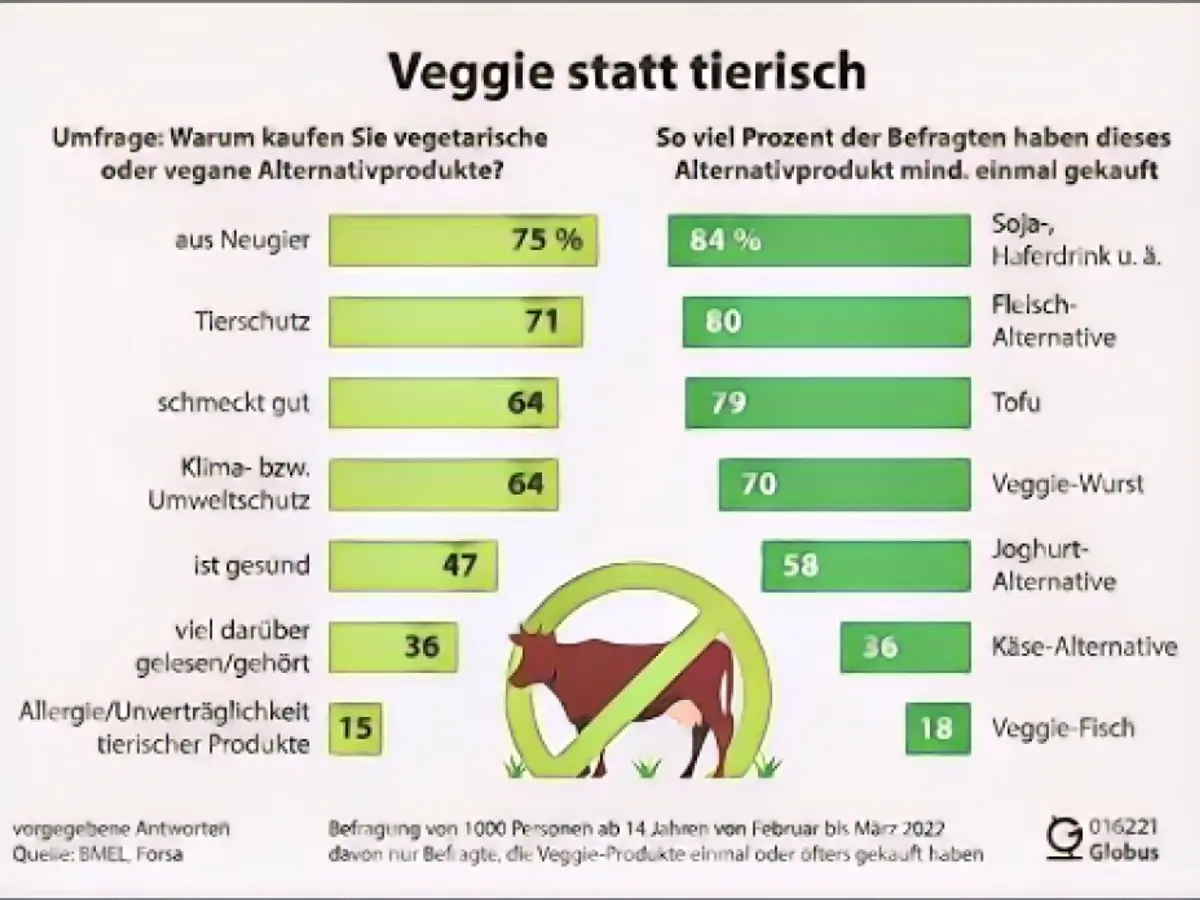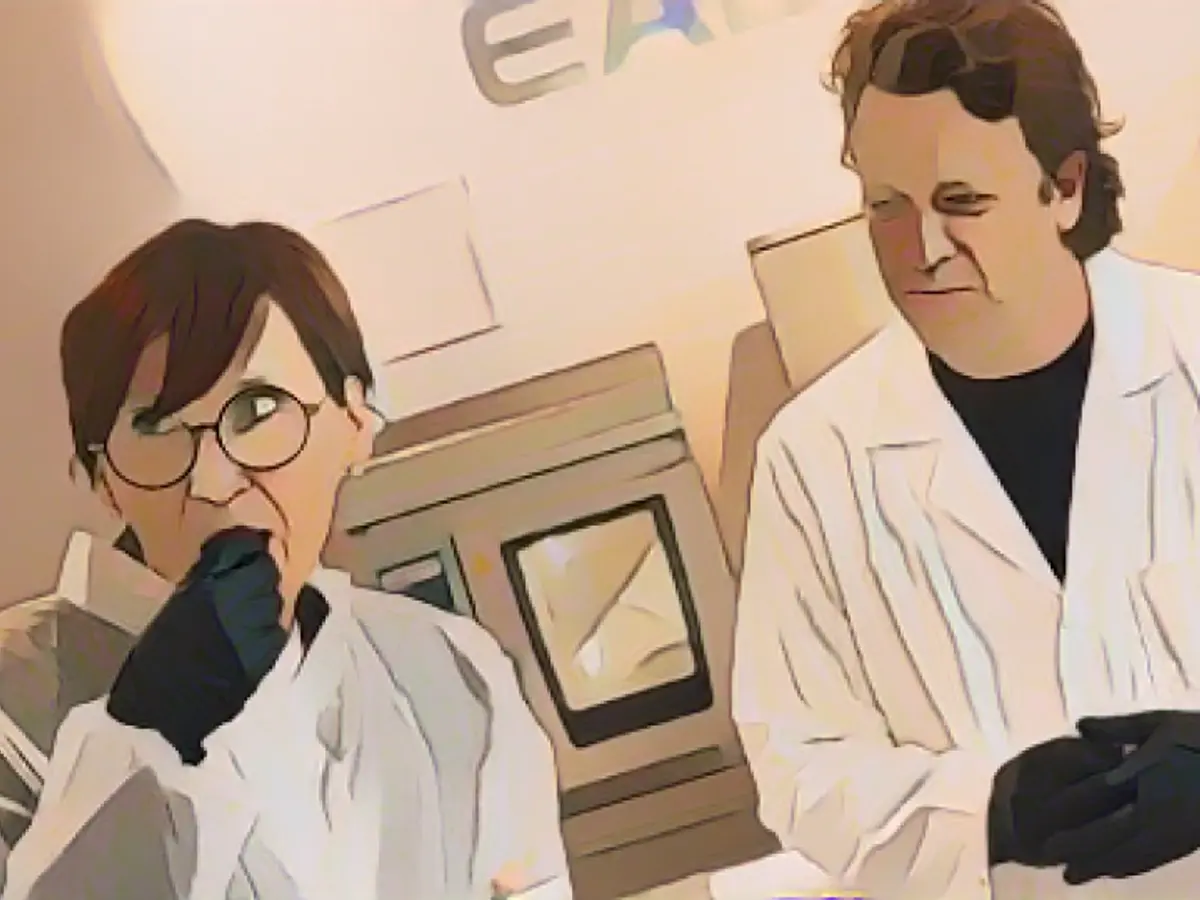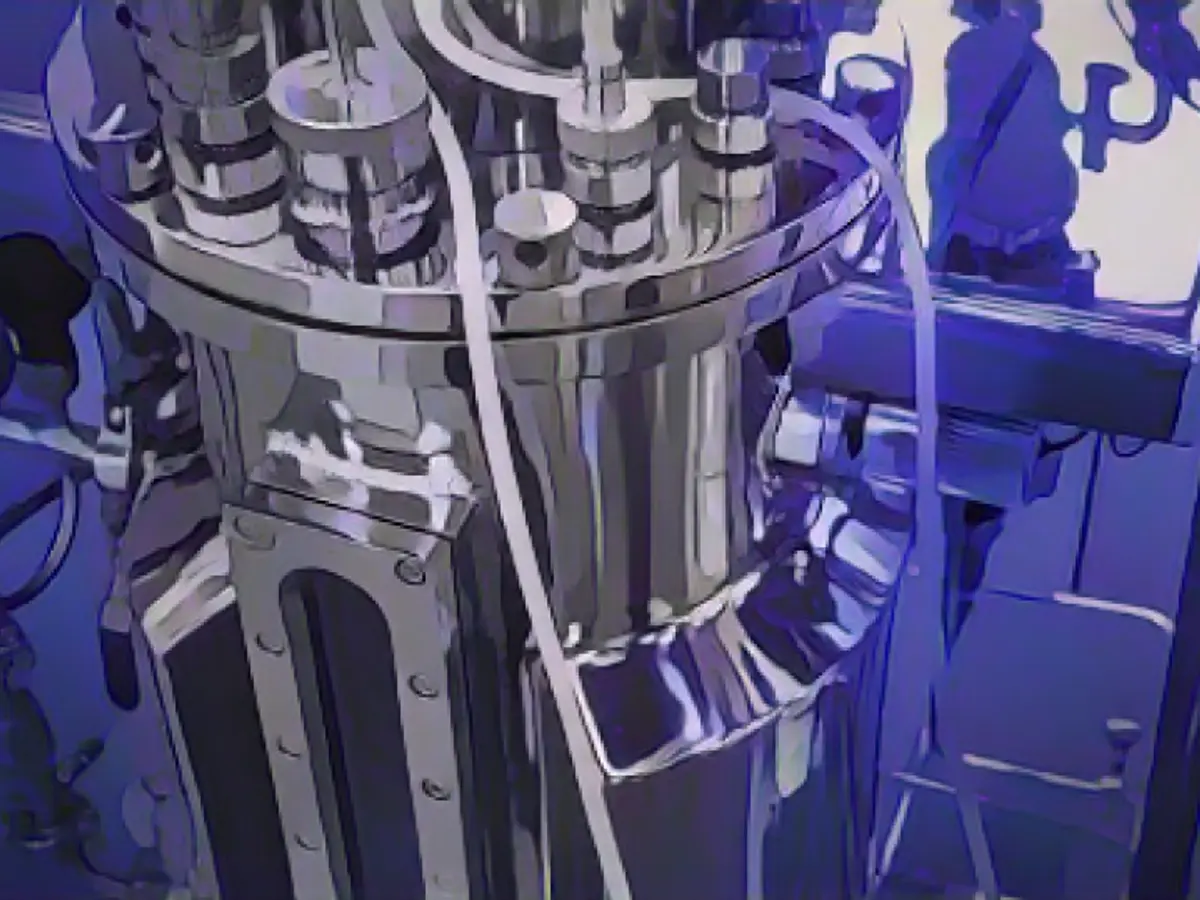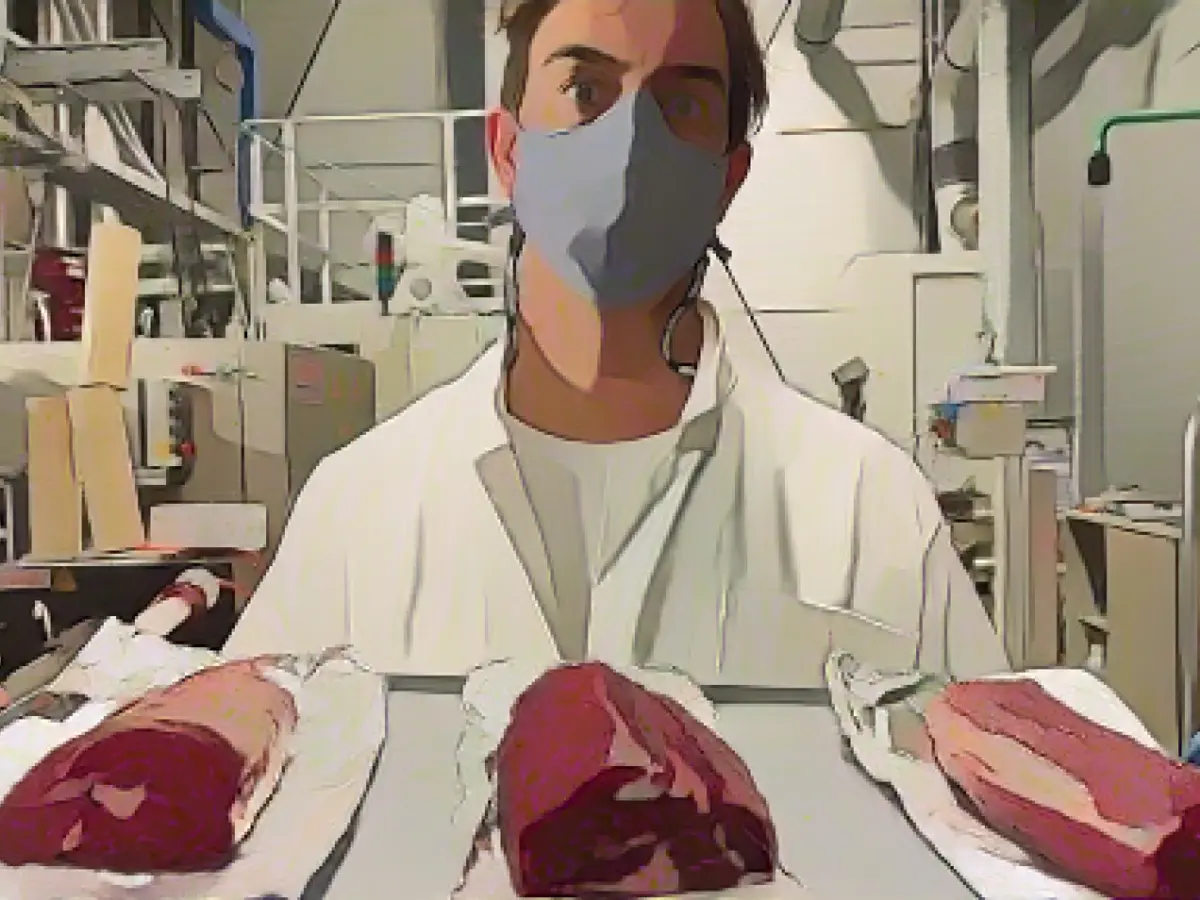Forget meat! - How veggie meat could overtake the original
When it comes to meat and its vegetarian alternatives, tempers run high. Opinions clash with enormous force, in social media anyway, but also in politics. Following heated debates, Italy's right-wing conservative government was the only country in the EU to ban meat imitations made from animal stem cells. Opponents disdainfully call it "lab meat", while supporters call it "meat from the fermenter". The battle between the meat industry and veggie suppliers has long been a struggle for the authority to interpret words. From now on, plant-based alternatives in Italy will have to be called something different from their animal-based originals. The government's reasoning is emotional. They want to protect the Italian tradition of eating and butchery.
In Germany, on the other hand, meat alternatives based on new technologies are seen as an opportunity, both economically and in terms of climate targets. Less than a week after the decision in Italy, the Bundestag released 38 million euros for a comprehensive program to promote a meat-free diet. The aim is to convert agriculture away from animal feed and towards protein-rich plants for food. In addition to proprietary soy varieties, the program also supports protein crops such as field beans, peas and alfalfa. Financial support is also provided to companies with new production processes for vegetarian products.
35 million tons of soya for European livestock - annually
Animal feed is currently grown on 70 percent of arable land. In addition, the EU has to import 35 million tons of soya from South and North America every year for animal feed production, the majority of which is genetically modified. The EU takes a critical view of this economic dependency, which is due to today's high-performance livestock species. The optimized dairy cow with almost ten tons of milk per year or the slaughter chicken, which weighs two kilos just six weeks after hatching, need the high protein density of soya from overseas.
But why give plant proteins to an animal for slaughter when they could also be processed directly into food that not only tastes good, but is also healthy and even similar to meat? The "protein plant strategy" has existed in Germany and the EU for around ten years, but the annual funding in this country has rarely amounted to tens of millions of euros and the money has mainly been used for the protein plants that livestock eat. This is set to change. In this respect, the 38 million euros could be interpreted as a commitment to change.
Godo Röben is certainly satisfied. He once transformed the former sausage company Rügenwalder Mühle into Germany's leading veggie supplier with more courage than knowledge. Today, he is turning bigger wheels. As one of the stakeholders, he helps decide how the multi-million euro budget is used as effectively as possible. Politically, Renate Künast and Dr. Zoe Mayer from the Green Party chair the advisory committee. It has not yet been decided which associations from the agricultural and food industry will join.
"A few other countries are investing more, but at least Germany can continue to keep pace with the leading group. And it is an important signal to all participants in the value chain - from farmers to food retailers," says Röben. His personal dream is to establish a leading competence center for alternative proteins in Germany, such as the "Food & Biobased Research Center" in Wageningen in the Netherlands. The Netherlands is investing more than 60 million euros in a complete ecosystem for plant proteins, while Denmark is even investing 300 million euros in its "protein turnaround".
When it comes to plant proteins and vegetarian products, Godo Röben has a passion that you wouldn't necessarily expect from a down-to-earth guy from the Oldenburg region. Röben is firmly rooted in his home and has always lived in Brake an der Unterweser. A film crew had chosen the place in search of the most depressing location possible, he says, not without local patriotism.
Godo Röben "We will always eat meat"
The topic of vegetarian food grabbed him at Rügenwalder at the time. With little knowledge and hardly any experience, they had built up a new brand, not only opening up a market, but largely creating it themselves. Röben had a hand and nose in the entire veggie value chain like no other. From the product idea, food technology, sourcing of ingredients, recipes, production, sales to marketing and lobbying in politics. Today, he drives the German veggie scene forward as a networker, investor and consultant on various advisory boards. Among other things, he advises the Rewe Group, food manufacturers such as InFamily Foods on their vegetarian spin-offs, invests in start-ups and is on first-name terms with many politicians.
However, Röben is not a veggie missionary. "If I'm out with friends somewhere and there's currywurst, I don't turn it down. But if there are tasty vegetarian alternatives, I go for them," he says. Humans have been hunting, keeping and eating animals for tens of thousands of years, he says. Meat will always be eaten, says Röben. The only question is how much. In any case, things cannot continue as they are at present. The meat industry is one of the biggest climate and environmental polluters, from the cultivation of animal feed and animal husbandry to the transportation of animals and storage of manure. Ruminants such as cattle in particular produce a considerable amount of CO2, methane and nitrous oxide during digestion. Although methane and nitrous oxide are more volatile than CO2, they are many times more harmful to the climate. Overall, livestock farming contributes around 15 percent of the greenhouse gases produced by humans.
From a global perspective, time cannot be turned back. We can no longer go back to the 1960s, when farmers took their handful of pigs to the butcher to cover their customers' meat requirements. "Back then there were three billion of us on the planet, today there are eight and it won't be long before we're ten billion. The Bullerbü era is over, we can only feed this number with alternative proteins and new processes," says Röben. His goal is a share of alternative proteins of up to 40 percent by 2040 in Germany.
In 40 years, meat from plants will be completely normal
"I believe that such major turnarounds always follow the same pattern over a period of 40 to 60 years, whether it's the mobility turnaround, the energy turnaround or the switch from meat to veggies," says Röben. The energy transition began in the 1980s with the anti-nuclear movement. "The first ones are always the freaks who make everyone else wonder what they actually want." At first, this group was against nuclear power and then turned its attention to fossil fuels. A good 20 years later, what was once considered an outlandish attitude finally became suitable for the masses and thus politically viable. Around 40 years after the first "Nuclear power - no thanks" stickers, Germany now obtains 40 percent of its energy from renewable sources and wants to reach 80 percent in the near future.
The same will happen with the change in diet. The decisive factor for success is not vegetarians or vegans, but flexitarians, meat eaters who are open to alternatives. According to surveys, they make up 45 percent of potential veggie customers in Germany. Flexitarians like meat and sausage, but would switch for reasons of animal welfare and climate awareness - if the product alternatives can keep up with the original.

"For the first vegetarian meat-like products a good 20 years ago, you had to be a deeply convinced hardcore vegetarian. It didn't look good, it didn't feel good and it didn't taste good either," recalls Röben. Today, we are already a step further, and we can manage bologna, meat salad, burger patties and salami quite well. But most flexitarians are still not convinced. "They try it, but then say no, I don't like it and won't come back for another year or two. That's also the reason why the industry isn't getting up to speed quickly enough. We need to improve faster here," says Röben.
"No additives or good taste? You can't have both"
This also applies to the ingredients. "With the first veggie products, the developer said to me: What do you want? No additives or good taste? You can't have both," recalls the ex-Rügenwalder manager. "It was clear to me that the only way to get people to buy these alternatives was through taste." The first meat substitute products ten years ago were made with plant proteins, spices from the well-known sausage recipes and a number of additives. They were not squeamish. The intrinsic values did not play a role in this phase. Nor did where the plants came from. The soy was imported from South America because it was cheap. Many products had the nutritional value of edible paper.
From there, it took nine years of research and development before the meat alternatives were ready to be healthy and taste good. In the salami and ham of the new "Billie Green" brand from Plantly Butchers, the proteins do not come from overseas, but from German wheat. The wheat is fermented, which increases the protein yield by a third compared to older processes. According to Röben, additives are no longer needed, marking the start of the next stage of development: away from the butcher's trade and towards food technology.
Completely new processes for the plant-based meat of tomorrow
Until now, most vegetarian meat alternatives have been produced using traditional sausage processing machines. Meat sausage, for example. Instead of meat, vegetable proteins, spices, water and oil are mixed into a mass in the so-called cutter and pressed into molds. This would not be necessary, as many vegetarian ingredients are supplied in powder form. However, manufacturers are saving on the purchase of new machines. But that is exactly what is changing. The old technology could be used to produce vegetarian meat sausage, mince or a veggie meatball, but it is unsuitable for more complex products.
In the search for vegetarian alternatives that actually feel like a steak or salmon fillet, traditional craftsmanship and its machinery have largely become obsolete. Vegetarian raw materials can be processed in 3D printers, grown from animal stem cells or constructed using precision fermentation. The future of food sounds like food IT.

Suddenly, start-ups from completely different sectors appear around the corner. Project Eaden from Berlin brings know-how from textile technology. They transform plant proteins into muscle fibers and connective tissue. Millions of these thin fibers are then joined together to form large pieces of meat. They can imitate the structure of meat, from steaks and roasts to ham, with a realistic look and chewing sensation," says Röben enthusiastically. "And they have also made great progress recently in terms of taste and roasting behavior." Röben finds it particularly interesting that, unlike meat from a 3D printer or fermenter, Project Eaden can use textile technology to bring large quantities to the market at low prices.
Closer to meat, at least thematically, is a project from the BioMedical Printing Technology department at TU Darmstadt. The department, which is only three years old and is part of the Mechanical Engineering division, is working on printing implants for regenerative medicine, among other things. This may not sound very appetizing, but whether the spare parts made from cells are built into people or eaten by them is technically irrelevant. The scientists are convinced that their screen printing process can produce the finest muscle fiber-like structures. This involves stacking layers of cells half a millimeter thick on top of each other, which then grow together to form a solid structure. So far, it has only worked in the laboratory.
Redifine Meat and Jucie Marbles: alternatives for meat lovers
Röben's love of experimentation is not dampened by such images. "I ate a steak from Redefine Meat that was really good. The feel, grain and color were all very close to the original. They achieved this with a 3D printer that prints the tissue from muscle cells and fat cells from commercially available proteins," says Röben. Or Jucie Marbles from Slovenia. "If you want to treat yourself to something really good, you order a 750 gram steak from them. You cut it into fillet pieces and fry them in butter. Fabulous! Hardly distinguishable from real meat", Röben is in his element. The disadvantage of all these top techniques is that they do not scale. Only small quantities can be produced, at a non-marketable price.
And that brings Röben back to his time horizon of big turns: It took ten years for meat substitutes to gain market acceptance, ten years to actually turn the products into healthy foods and it will then take another ten years to mass produce meat alternatives that are very similar to real meat in terms of taste and feel.
By then, fermentation will be the key technology for meat alternatives. Fermentation is an ancient technique in which microorganisms such as bacteria or algae convert a raw material to give it flavor, make it more digestible or increase its nutrient content. Pressed grapes are turned into wine, milk into yogurt and soybeans into soy or miso sauce. According to the Good Food Institute, 136 companies worldwide specialize in fermentation, and 100 companies operate product lines based on alternative protein fermentation, including industry giants such as Unilever and Nestlé. The US think tank "RethinkX" even predicts a fermentation revolution in the US meat and dairy market, with the number of cattle halved by 2030.
The future belongs to mushrooms and precision fermentation
In biomass fermentation, the organisms themselves are the end product: fungi. Hamburg-based start-up Infinite Roots and Bosque-Foods from the USA are working on this technology. The mycelium grows in a nutrient solution in large fermenters, around 25 times faster than soy plants. It is then harvested, processed into a dough-like mass, seasoned and can then be formed into meat-like products: Schnitzel, meatballs, meatballs.
Whether a meat alternative is popular with customers also depends on how it behaves in the pan. Does it sear well, does it remain firm in the oven or does the meat fall apart when braised? According to Infinite Roots, mushrooms keep their shape under heat compared to other plant proteins, as their structure is closer to that of animals than plants. The Hamburg-based start-up is also researching a climate-friendly raw material cycle. Theoretically, the nutrient solution for the mushrooms could also consist of waste products. For example, coffee grounds or pomace from fruit juice production would no longer go into animal feed, but directly into the next veggie food.

The current cutting-edge technology is precision fermentation. In this process, microorganisms produce ingredients such as flavorings, enzymes, vitamins or colorants. Thanks to advances in bioinformatics, it is now possible to select bacteria specifically for a task or to program them to produce the required substances using genetic engineering. This makes it possible to "tune" vegetarian meat alternatives and, for example, add nutrients and the typical meat taste that can otherwise only be found in the animal model.
Not just meat: cheese can also be recreated
The technology could also change the world of dairy products in the long term - and be good for the climate. Around 87 percent of greenhouse gases from livestock farming are attributable to the rearing of beef cattle and dairy cows. Sixty years ago, a dairy cow produced 6,000 liters of milk per year; today's high-performance breeds produce 10,000 liters and more. Keeping these sensitive animals is expensive and requires special feed, controlled environmental conditions and ongoing health checks. These high costs are offset by a brutal price war on the market.
More and more companies around the world are researching which animal amino acids are responsible for the typical taste and physical properties of cow's milk. The amino acids are reproduced in fermenters using appropriately programmed microorganisms. This enables vegetarian versions of milk, cream, cheese and yoghurt that are very similar to the original. Compared to animal farming, significantly less methane and CO2 would be emitted and only a fraction of the energy and water would be required. This is not a dream of the future. The company "Formo" from Berlin produces "nature-identical" cheese in this way. However, the veggie cheese is not available to buy in Germany; it is due to be launched on the market in Asia this year. The approval procedures there are less strict than in the EU.
When it came to the third meat production technique, even Godo Röben had to swallow at first: Meat from the fermentation tank based on muscle or stem cells. Stem cells or muscle cells are taken from the animal via a biopsy and used after purification in the fermenter. Stem cells are body cells with an as yet undefined function. They can become anything. In the fermentation tank, they become muscle cells and fat cells that grow around a scaffold of soy and wheat proteins. At the end of the process, a steak falls out of the fermenter. In Israel, "Aleph Farms" is working on the process, in Germany "The Cultivated B", a subsidiary of InFamilyFoods from Heidelberg.
What we perceive as normal production will change
"I'm quite honest about that. I also found the idea of meat from the fermenter strange at first," admits Röben. The more intensively he looked into it, the more differentiated his image became. What would an extraterrestrial say, he asked himself? "On the one hand, he would see a piglet that is crammed in without daylight and fattened up within six months, only to be killed in a panic and dismembered by machines. On the other hand, he would see a fermenter in which meat is produced from a single animal cell. What would he consider more "abnormal"?" says Röben, explaining his change of heart.
The production of plant-based meat alternatives has nothing to do with the image of happy animals, green meadows and traditional livestock farmers. "It will take two generations to get used to the fact that this production is unappetizing and technical," Röben is certain. "But what we do in meat production today is much less appetizing. But we have been socialized in this way and therefore find it normal. Any change is then initially perceived as strange".
However, it will be years of research and development before fermented meat and comparable alternatives fill supermarket shelves en masse. Many alternatives such as meat from fermenters or precision fermentation fall under the EU Novel Foods Regulation and are only approved after intensive testing. The Italian government has therefore banned something that does not currently exist anyway. Until then, you can buy plant-based meat anywhere. Even in Italy.
Read also:
- Why there is still no EU funding for green Saar steel
- 3 billion Saar Fund is unconstitutional
- Politicians at a loss after shock news
- Court of Auditors criticizes the state government's debt plan
- Despite opposition from some countries, Germany is investing heavily in plant-based protein sources as alternatives to meat, providing funding for companies with new production processes and supporting the growth of protein crops like field beans and peas.
- In the debate over meat alternatives, some argue that it's more sustainable to process plant proteins directly into food for human consumption, rather than feeding them to animals for slaughter. This approach is known as the "protein plant strategy."
- Fermentation is a key technology in the production of meat alternatives, with 136 companies worldwide specializing in the technique, including industry giants like Unilever and Nestlé. Mushrooms are particularly promising as a source of plant-based protein, as they can grow faster and have a texture closer to animal meat than other plant proteins.
- Some start-ups are using precision fermentation to create meat alternatives, such as Redefine Meat, which uses a 3D printer to print tissue from muscle and fat cells. Other companies, like Jucie Marbles, are using alternative sources of protein, like peas, to create meat alternatives with a similar taste and texture to traditional meat dishes.
Source: www.stern.de








